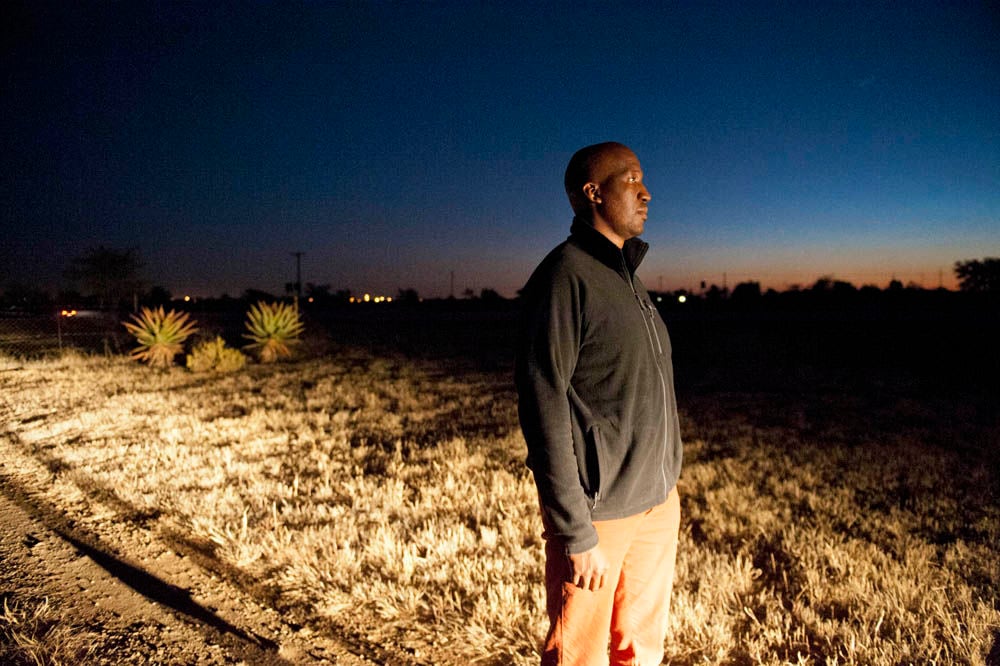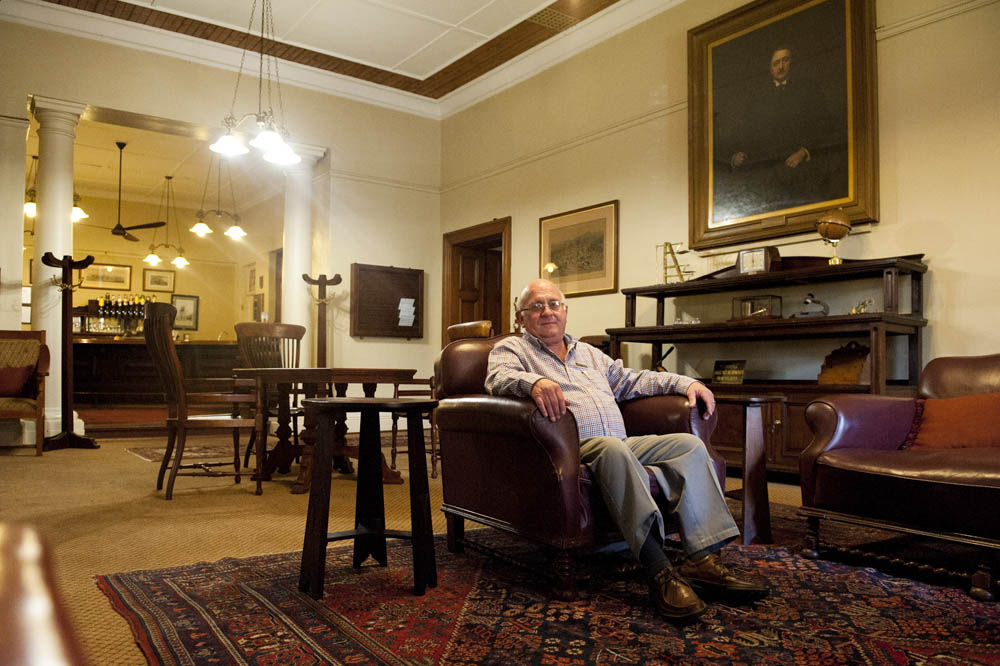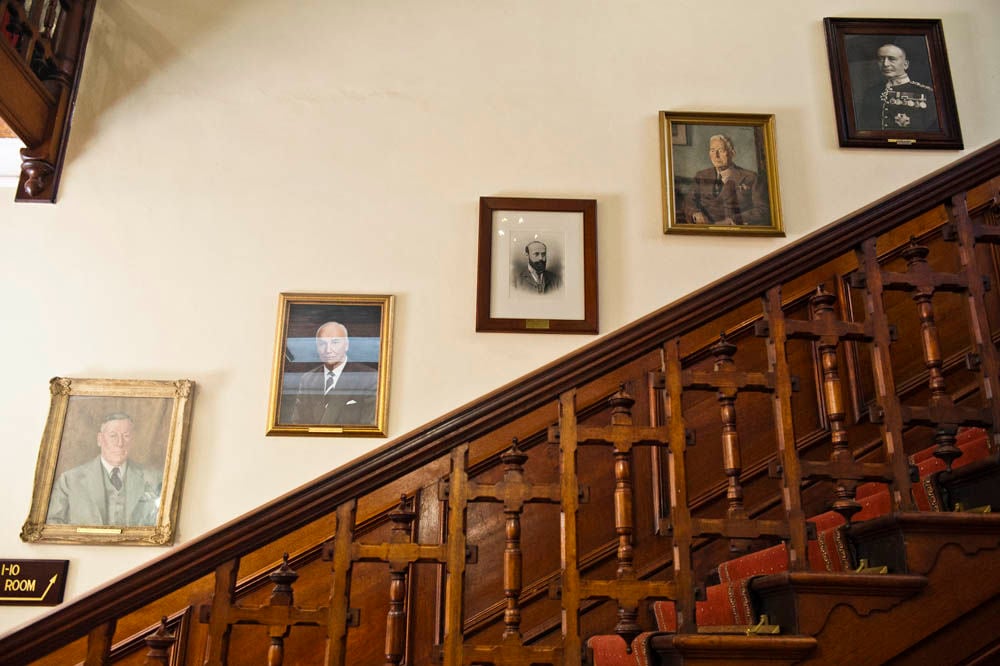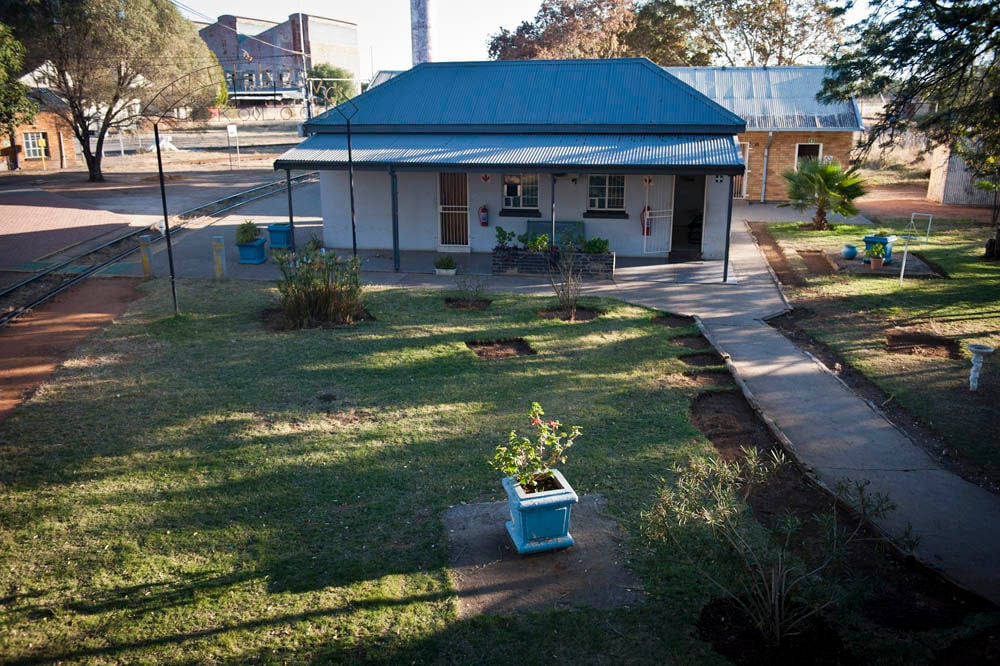Seemingly unwanted in Mahikeng
The larger-than-life statue of a three-piece-suited Cecil John Rhodes, hat in hand, was a feature on Mahikeng’s Station Road for at least 70 years, after it was completed by empire sculptor John Tweed in 1932.
When a part of the old town station was demolished in the mid-1990s to make way for a shopping mall, the statue was moved to an inauspicious location at the Mahikeng Transnet train yard. It was this relative obscurity that signalled its last days in Mahikeng, the northern town that was a key stop in Rhodes’s ambitious Cape-to-Cairo rail project.
In 2009, following instructions apparently from within Transnet that it be removed – along with other artefacts like a telephone booth and a railway push trolley – the statue was moved rather conspicuously, in broad daylight, by a “bunch of white guys”, as lifelong Mahikeng resident Galefele Molema puts it.
For the past four years Molema has become a man of letters, words and action – all rolled into his imposing, bald-headed two-metre frame. He has been driven by efforts to locate and return the equally imposing statue he has christened “Cecil Gone Rhodes”.
One doesn’t have to work hard to find a scathing appraisal of Rhodes’s impact on the continent. In a 2006 Mail & Guardian article headlined “A most unsavoury rehabilitation“, African scholar Adekeye Adebayo writes of his internal conflict in being awarded a Rhodes scholarship to study at Oxford University in 1990. Adebayo also expresses shock, a decade later, to find the imperialist being paired with Nelson Mandela for a jointly named scholarship.
Adebayo writes: “Rhodes, who died in 1902, undoubtedly remains the greatest individual historical symbol of imperialism. Independent Zimbabwe tore down his statues after independence in 1980. Zambia toppled a statue of Rhodes on achieving independence in 1964, and both countries – formerly named Southern and Northern Rhodesia– sought to remove the imperial stain by re-baptising themselves.”
He continues: “Rhodes used his economic wealth to buy political power, and used political power to protect and extend his wealth. He headed the De Beers mining firm and dispossessed black people of their ancestral lands in modern-day Zimbabwe and Zambia through brutal and often treacherous means, stealing 3.5-million square miles of real estate in one of the most ignominious ‘land grabs’ in modern history.”
Preserved for posterity
Molema, while not oblivious to Rhodes’s problematic history, is more forgiving, believing that all of Africa’s history should be preserved for posterity.
“I acknowledge that Cecil John Rhodes did not acquire his wealth in the most virtuous of ways and indeed he was no saint, but he is a most notable figure in our history – not only in colonial-era mining in Kimberley, but he features prominently in the history of Southern Africa,” he writes on the Facebook page of the Mahikeng Society, a group of history and heritage enthusiasts cofounded by Molema to “do what the Provincial Heritage Resources Authority (PHRA) is supposed to be doing”.
“He is said to have been a lonesome, bad-tempered Englishman. He made his money in the Kimberley diamond diggings and by 1881 had been elected a member of the Cape Assembly,” he writes.
“His dream was to spread British colonial rule throughout the world. By using the modern inventions of railways and telegraphs as a link, he wanted the British Empire to stretch from one end of Africa to the other – ‘from the Cape to Cairo’, as some put it.”

Heritage activist Galefele Molema is waging a one-man battle to get the contentious sculpture returned to his hometown.
Molema became obsessed with returning the statue to Mahikeng after learning of its disappearance.
“I noticed in 2010 that it was gone,” says Molema by phone from his farm in Signal Hill, Mahikeng.
“I was jogging over the railway bridge with my cousin and I looked down and I noticed that there was no statue. My cousin stays in a heritage house. He wanted to do renovations, but the PHRA was on his case. They mentioned to him that he has to abide by the PHRA rules. But then Transnet didn’t have to abide by any rules [when facilitating the statue’s removal] and they have a legal department.
“I went down to the station and I asked around there,” says Molema. “Nobody knew where it was. Somebody said they thought it was in a Kimberley museum.”
Search for the statue
Molema, a farmer who still dabbles in his previous job as an advertising creative, ramped up the search for the statue. He phoned the McGregor Museum in Kimberley, where staff members said they didn’t know anything about the piece but would look out for it.
Then the statue specialist at the museum said he saw it at the Kimberley Club. To confirm the spotting, Molema posted a photo of the statue on the Mahikeng Society Facebook page and received a response: “I spotted it at the Kimberley Club,” someone wrote in. “I thought it was a replica, but then I remembered the one in Mahikeng was missing.”
“There was a long time when everybody was quiet and Transnet wasn’t answering my emails,” says Molema. “Some people at Transnet said it was the area manager at the Mahikeng train station who had it moved without explaining why.”
Molema returned to Facebook to establish whether there were any witnesses to the removal, and he received a slew of photographs from a Mahikeng resident named Phillip Keet.
One photograph featured Kimberley Club secretary Randall Bruce in a windbreaker, cardigan and jeans, posing with a sense of accomplishment next to the upright statue, which had just been removed from its stone plinth at the Transnet yard. Bruce clutches two rolls of tape, ready for the next phase of the appropriation.
Now certain of the statue’s location, Molema began communicating with Bruce by email. He emailed and called a long list of Transnet personnel who might have known about the instructions to either remove the statue or donate it to the Kimberley Club.
From the emails gleaned, the responses from Transnet staff were laconic and indirect. After a cursory exchange of emails with Bruce, Molema suggested the two meet for a face-to-face conversation.
Heritage household
We meet Molema at his Mahikeng home. The household has several structures, a spacious yard being dutifully swept by a middle-aged woman, a small orchard and several acres of open land for his livestock.
The Mahikeng we see is a mixture of crumbling Victorian-era double-storey buildings (some of them modified with little attention to rules governing heritage sites) and black aspiration in the form of palatial houses and ubiquitous small businesses. This is a place is where colonial grandeur gives way to a hybridised, 21st-century Africa.
Molema points us to the old quarter of town, with buildings such as the grand but creaky St Joseph’s Convent, and says it should have been turned into a heritage precinct. We go to the railway station where the statue last stood in Mahikeng. A diminutive blue flower pot with a lone red rose now stands in its place.

Kimberley Club secretary Randall Bruce says he was told he could take the statue after hearing that it would be discarded. (Delwyn Verasamy, M&G)
In the dead of night we journey to Kimberley. Probably because of the cold, the more than four-hour journey seems to last a lifetime.
Not even the knowledge that you’ll be greeted by a stern-looking Rhodes at the entrance to the red-brick Kimberley Club prepares you for the statue’s impact at close range. It dwarfs you, temporarily at least, turning Rhodes into some kind of human pyramid.
It stands against a wall, near to a side entrance of this 19th-century styled colonial edifice. It is the crown jewel of a club Rhodes helped found with fellow diamond moguls.
Tale of reclamation
The next day, Molema is keen to hear Bruce recount the tale of the statue’s reclamation. We meet him for tea in a spacious lounge overlooking an “absolutely original” wooden bar from 1895.
Bruce points around the room. There is handmade furniture from the same period in one corner. Rhodes sat there, Bruce tells us. A large portrait of a seated Cecil John Rhodes watches over us.
Bruce says he was alerted to the statue’s possible demise by “a friend who was in the area” who then gave him “a guy’s name at Transnet”.
Hearing that the statue was about to be “discarded” in the next few days, Bruce says he asked whether there would be an objection if he came, fetched it and “stored” it. Getting the go-ahead from a mysterious source, Bruce said he phoned a friend with a two-tonne truck and a crane and got it moved the next day.
• See also: Where apartheid statues go to die
It’s Bruce’s next comments that make earlobes perk up and reach for the rewind button: “Obviously there was quite a crowd that had gathered, watching this and all the rest of it, because it was on that railway property. The one guy came up and said: ‘That thing’s worth money. We can get money for it.’
“That’s when I said to the guys, because we wanted to take the plinth and everything: ‘Just load up and let’s just get going.’ That thing is heavy, hey. It’s a two-tonne crane, and the safety valve was starting to weep.”
Minimal damage
And then, explaining the minimal damage the statue suffered in transit, Bruce again alludes to the fact that a Transnet staffer interrupted his five-man gang by raising an objection.
“So we didn’t take any of the pattern off or anything like that. But there was an area where it was scratched because one of the guys said: ‘Hey hey hey, that thing’s metal – it’s worth a lot of money. We can sell it.’ I just thought: ‘Whoops … I think it’s just in time, guys.’
“But as I say, it was going to be discarded. And then there would have been nothing.”

The staircase at the Kimberley Club. (Delwyn Verasamy, M&G)
The quotes are most bizarre because they seem to imply the awareness of wrongdoing. And yet Bruce, in galloping speech, utters them without a change of pace.
For Molema, Bruce’s conduct points to a level of contempt for protocol. “If you notice in the letter Randall Bruce sent to me, it says [the Mahikeng Society] doesn’t have authority, and says I need a letter from an official company or a state office if we want it [the statue] released.”
In a letter dated February 17 2004 sent to the Mahikeng Society, Bruce writes that “any insinuation that the statue in question was obtained by the Kimberley Club under suspicious circumstances will be vehemently denied and any such insinuation should be disregarded at all times.”
Tactically, he adds: “Should the claim of the entity you represent be lawful and we are obliged to render the statue back, the return of the statue would have to be done at the cost of the lawful entity.”
‘No paper trail’
According to Molema, there has been “no paper trail” denoting the ownership of the statue – it appears to have been erected by admirers of Cecil John Rhodes in the 1930s.
The impetus to remove the statue seems to have emanated from a wider political agenda in line with the then new regime’s political sensibilities.
A North West communication service press statement on September 21 1995, on the removal of former Bophuthatswana president Lucas Mangope’s statue from the Lehurutshe Civic Centre, quotes then North West chief whip Joe Selau as saying that “the mandate of the people has been carried out”.
This was despite Lehurutshe residents complaining that they weren’t consulted by the government about the removal. Selau, who also chaired the committee elected to deal with statues within the province, said that Rhodes’s statue erected in front of the Mahikeng railway station would be the next to go, but that no one had shown interest in storing the statue.
It’s not clear how Selau established this because the report notes that local residents complained of no public participation. The statue’s date with destiny, it seems, had been booked since 1995.
According to the National Heritage Resources Act of 1999, it is the role of the South African Heritage Resources Authority and the relevant provincial subsidiaries to identify, record and manage nationally significant heritage resources and keep permanent records of such work.
The scope of duties is wide ranging but includes the assisting of “any other body concerned with heritage resources management”.
Intention to repatriate
This means that Molema and his associates at the Mahikeng Society could call on the provincial heritage body. North West PHRA co-ordinator Mothlabane Mosiane said they have spoken to Molema but a decision is yet to be made about his intention to repatriate the statue.
“The board was meant to have met, but it has not met yet. The board is supposed to meet four times a year, but it is currently meeting on an ad-hoc basis due to unforeseen circumstances,” Mosiane told the M&G.
“The matter does fall within our jurisdiction. There are also financial matters to consider.” He said no date has been set for a board meeting.

A pot plant now stands in the spot where Cecil John Rhodes’s statue used to be located at the Mahikeng railway station.
But Molema’s sustained efforts with Transnet and the Mahikeng Museum already appear to be reaching a nadir. “I sent a letter to the curator of the Mahikeng Museum [Sello Mashile], and while he said he didn’t know about the statue he said he would be willing to accommodate it.
“I called the Transnet head of heritage and he contacted the curator, but what they spoke about nobody wants to tell me. It should be an open discussion because it’s public art. But if Transnet wanted to return it, they could just load it up on a train or a truck with a hydraulic arm.”
Investigation
Mashile said he has not communicated with the people who had the statue, nor Transnet. But Brian Murison, a spokesperson at Transnet Corporate, said the parastatal has just completed an investigation surrounding the statue’s removal from Mahikeng.
“The matter has been forwarded to Transnet Freight Rail for further action,” Murison said, promising to be in contact as soon as “I have more information on how they will move forward”.
Says Molema: “But the department of arts and culture, too, has been slow to respond. They said they’ll get back to me. I think with them, it’s like Cecil John Rhodes is a villain. If people in Mahikeng don’t want it, you could sell it to Britain or to the Kimberley Club, but do not let guys have it for free. People go to the Kimberley Club to take pictures with the statue. They’ve incorporated it into their marketing plan.””
The journey back to Mahikeng happens on a sunny, wintry afternoon. It is less upbeat and seems to symbolise the proliferation of question marks outnumbering answers.
I can’t help but wonder why Molema, a veritable renaissance man, has expended so much energy on this project when Mahikeng seems just fine without – as one Transnet employee put it – the strange leburu (white man) on its stoep.
The M&G had received no comment from the department of arts and culture at the time of publishing.